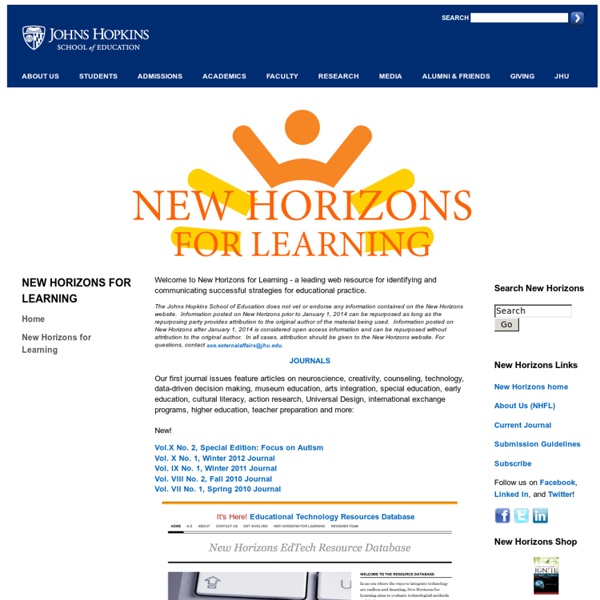The Association for Bright Children Ontario
New Horizons for Learning | EdTech Resource Database
Center for Research on Education, Diversity & Excellence (CREDE)
The Center for Research on Education, Diversity, and Excellence (CREDE) Hawai‘i Project promotes educators’ use of research-based strategies of effective practice for culturally and linguistically diverse students. These strategies are derived from Vygotsky’s theory and over 30-years of research from the national CREDE project, now at University of Hawai‘i at Mānoa. These standards were recognized by the national What Works Clearinghouse. The CREDE Standards: Joint Productive Activity: Collaborating with students to create joint products.Language and Literacy Development: Developing competence in the language(s) of instruction throughout the day.Contextualization: Connecting new information to what students already know and teaching in culturally relevant ways.Complex Thinking: Challenging students toward cognitive complexity.Instructional Conversation: Teaching through dialogue.Modeling: Promoting observational learning.Child Directed Activity: Encouraging students’ decision-making.
Helping Shy Students
All teachers have had shy students in their classroom. These children are the ones who keep to themselves and quietly complete their work, often hiding from the attention of the teacher or their classmates. However, some of these children are not just shy or quiet but may have social anxiety disorder. For these students, simply going to school everyday and interacting with other children and adults makes them feel extremely anxious. They are excessively shy, have an intense fear of social and performance situations, and are concerned about humiliation or embarrassment. Anxiety may be excessive enough that anticipation of a social event may provoke a panic attack or cause intense distress. How do teachers know if a student is suffering from social anxiety? Disproportion—Is the stress unrealistic for the situation? What specific behaviors should teachers look for in the classroom? What can be done to help students with social anxiety? Situation/Environment—What situations cause anxiety?
The Flipped Classroom Guide for Teachers - eLearning Industry
As technology becomes increasingly common in instruction at all levels of education from kindergarten to college, the modern classroom is changing. The traditional teacher-centered classroom is falling away to give students a student-centered classroom where collaborative learning is stressed. One way educators are effectively utilizing online learning and changing the way they teach is by flipping their classrooms. What is a Flipped Classroom? High school teachers Aaron Sanns and Jonathan Bergman were the first to flip their classrooms. In order to watch this video you need to have advertising cookies enabled. While a traditional classroom is teacher-centered, a Fipped Classroom is student-centered. The Flipped Classroom model might sound like new-age mumbo jumbo to you, but it has been proven to be effective even in the most difficult classrooms. Unlike the traditional classroom model, a Flipped Classroom puts students in charge of their own learning. Action? Homebase Make work easier.
Resources - National Association for Multicultural Education
The mission of our good friends at the PeaceJam Foundation is to create young leaders committed to positive change in themselves, their communities and the world through the inspiration of Nobel Peace Laureates who pass on the spirit, skills, and wisdom they embody.” Join one of the most exciting youth movements of our time: PeaceJam and The Global Call to Action. PeaceJam brings young people together with Nobel Peace Laureates to tackle the toughest issues facing our planet – issues ranging from basic needs, such as access to water, to basic rights, such as stopping the cycle of violence, and expanding social justice and human security. Change starts here. The PeaceJam Foundation provides five curricular programs that explore the stories of 12 Nobel Peace Laureates and the ways they overcame problems in their communities. Youth study the personal experiences of these amazing world leaders and then engage in service-learning activities that address local needs. General Books Awesome Library
Differentiating Instruction
Within the four ways for differentiating instruction there are embedded several other learning strategies which are used in conjunction with each other. The Strategies: Readiness / Ability Teachers can use a variety of assessments to determine a student's ability or readiness. Also, to learn new concepts students may be generally working below or above grade level or they may simply be missing necessary prerequisite skills. However, readiness is constantly changing and as readiness changes it is important that students be permitted to move between different groups (see flexible grouping). Varying the level of questioning (and consequent thinking skills) and compacting the curriculum and are useful strategies for accommodating differences in ability or readiness. Adjusting Questions During large group discussion activities, teachers direct the higher level questions to the students who can handle them and adjust questions accordingly for student with greater needs. Compacting Curriculum
Incorporating Differentiating Instruction Into Your Classroom New Teacher Resources
Learn about Teaching Channel Plus for Schools & Districts Sign In or Sign Up New Teacher Survival Guide: Differentiating Instruction Grades 9-12 / Science / Lesson Planning Embed Video Series Title Sequence New Teacher Survival Guide Differentiating Instruction Program Transcript ACT 1 : Meet Laura / Set up Differentiation Open on an empty Herrick's High school, flag flying in the breeze. Error loading player: No playable sources found <div>Please enable Javascript to watch this video</div> New Teacher Survival Guide Series New Teacher Survival Guide: Technology in the Classroom Grade 6 / Social Studies / Technology 17624 > Lesson Objective Watch a new teacher's first attempt at a differentiated lesson Length 12 minutes Questions to Consider Why is assessment a key part of differentiation? Teacher & School Info Laura Gurick Science / Teacher East Williston Follow School Details Herricks High SchoolNew Hyde Park, NY Population 1,374 students District Spending Data provided by Greatschools.org License Type



